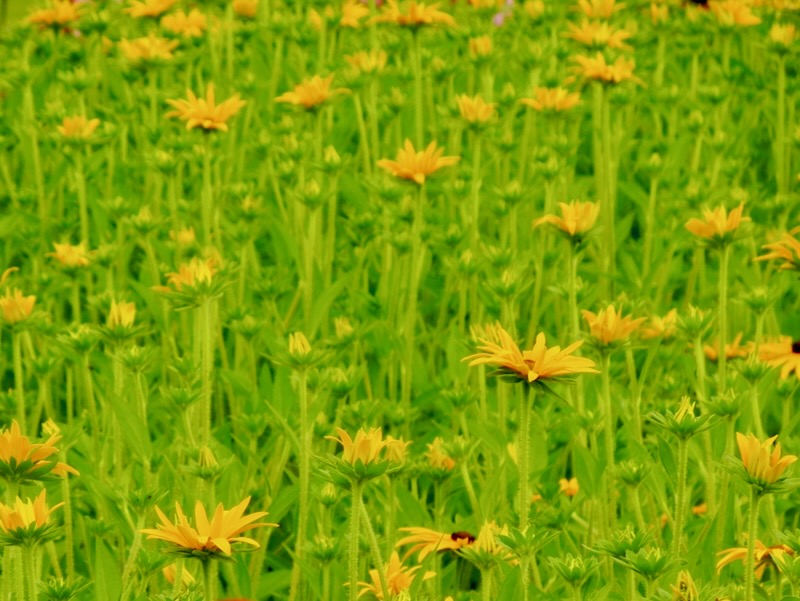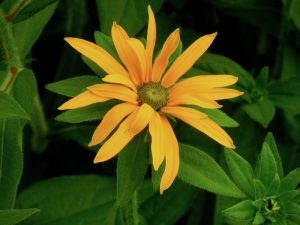Rudbeckia fulgida var. deamii: The Vibrant Late-Summer Bloomer
Rudbeckia fulgida var. deamii, commonly known as Black-Eyed Susan or Deam’s Coneflower, is a stunning late-summer perennial that brings vibrant golden yellow flowers to gardens when many other plants are winding down. With its masses of charming, daisy-like blooms and a robust, low-maintenance nature, this plant is a favorite among gardeners and landscapers.
Common Names: Black-Eyed Susan, Deam’s Coneflower, Deam’s Black-Eyed Susan
Scientific Name: Rudbeckia fulgida var. deamii
Family: Asteraceae (Aster Family)
Botanical Background
Rudbeckia fulgida var. deamii is part of the Asteraceae family, which includes many composite flowers and includes many other popular garden plants. The genus Rudbeckia is named in honor of the 17th-century Swedish botanists Olof Rudbeck and his son Olof. The species epithet “fulgida” means “shiny” in Latin, referring to the glowing golden flower rays, and the variety name “deamii” honors American botanist Charles Deam, who discovered this species in the wild in Indiana.
Plant Description
Height: 60-90 cm (2-3 feet)
Spread: 30-60 cm (1-2 feet)
Flower Color: Golden yellow with a chocolate brown cone
Foliage: Dark green, oval leaves
Rudbeckia fulgida var. deamii is a clump-forming, erect perennial that grows up to 90 cm tall. It boasts sturdy, pubescent stems and leathery dark green leaves that are oblong and toothed, maintaining a consistent size even on upper parts of the plant. The flowers are daisy-like, about 7 cm (3 inches) across, with 12-21 golden yellow rays surrounding a prominent dark brown central cone. These flowers bloom profusely from late summer through mid-fall, often covering the foliage completely.
Ornamental Features
Flowers: The bright golden yellow flowers with chocolate brown cones are the highlight of this plant. They attract butterflies and other pollinators, making the garden lively and colorful.
Foliage: The dark green, oval leaves provide a lush background that complements the vibrant flowers.
Habit: With its upright and clump-forming habit, Rudbeckia fulgida var. deamii is ideal for borders, cottage gardens, and wildflower meadows.
Cultivation and Care of Rudbeckia fulgida var. deamii:
Light Requirements: Thrives in full sun for best flower production but can tolerate partial shade.
Soil Requirements: Prefers moderately fertile, moist, well-drained soils. It can adapt to clay, alkaline, or acidic soils and gravelly conditions.
Watering: Regular watering is needed until established. Once established, it is drought tolerant. In arid climates, supplemental irrigation is recommended, while rainfall is usually sufficient in more humid regions.
Fertilization: A light application of a balanced fertilizer in the fall can support healthy growth. Rudbeckia generally thrives without heavy feeding.
Pruning: Deadhead spent flowers to encourage continuous blooming and maintain a neat appearance. Leave the last flush of flowers to set seeds, which are enjoyed by songbirds. Cut back hard in early to mid-spring to prepare for the new growth season.
Mulching: Mulch with organic materials like shredded bark or compost to retain soil moisture and suppress weeds. In humid climates, avoid mulching directly around the stems to prevent rot.
Propagation of Rudbeckia fulgida var. deamii:
By Seed:
- Sow seeds in pots in a cold frame in early spring.
- Transplant seedlings once they are large enough to handle.
By Division:
- Divide plants in spring or autumn.
- Dig up the clump and separate it into smaller sections, each with roots and shoots.
- Replant the divisions immediately in prepared soil.
Pests and Diseases
Rudbeckia fulgida var. deamii is robust and highly disease-resistant. However, in hot, humid climates, plants may require good air circulation and occasional division to prevent foliar diseases.
Common Pests: Generally pest-free but can occasionally be affected by aphids and leaf miners.
Benefits and Uses
Pollinators: Attracts butterflies, bees, and other pollinators with its nectar-rich flowers.
Wildlife: Seeds are relished by songbirds, and the plant provides habitat for various beneficial insects.
Ornamental Uses: Perfect for perennial borders, cottage gardens, prairies, meadows, and wildlife gardens. Also used as cut flowers.
Drought Tolerance: Once established, it withstands dry conditions, making it suitable for water-wise landscapes.
Deer and Rabbit Resistance: Foliage is generally unappealing to deer and rabbits.
Conclusion
Rudbeckia fulgida var. deamii is a resilient and beautiful perennial that brings a burst of color to late-summer gardens. Its vibrant golden yellow flowers, coupled with a robust and low-maintenance nature, make it an excellent choice for a variety of garden settings. Whether used in borders, meadows, or cottage gardens, this plant will provide a stunning display that attracts pollinators and delights gardeners with its long-lasting blooms.



